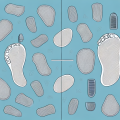If you’re considering using either an electronic pulse massager or TENS (Transcutaneous Electrical Nerve Stimulation) unit for managing your pain, you may be wondering which is better for you. Both have their advantages and disadvantages, so it’s important to do your research and find out which is the best type for your specific needs. This article will compare electronic pulse massagers and TENS units so that you can make an informed decision.
What is an Electronic Pulse Massager?
An electronic pulse massager is a small device used to administer electric stimulation to muscles. This type of electric stimulation is known as neuromuscular electrical stimulation (NMES), or “electro massage.” This type of device sends small electrical pulses through the skin, which can help to reduce pain, improve blood circulation and promote muscle relaxation.
Electronic pulse massagers are typically used to treat muscle pain, spasms, and stiffness. They can also be used to help improve range of motion and flexibility. Additionally, they can be used to help reduce inflammation and swelling, as well as to help improve circulation and reduce fatigue.
What is a TENS Unit?
A TENS (Transcutaneous Electrical Nerve Stimulation) unit is a type of device that sends electrical impulses through electrodes placed on the skin to treat pain. It is commonly used for pain associated with arthritis, back pain, and neck pain. By stimulating the nerve endings, the TENS unit is able to block the transmission of pain signals to the brain. It does this by sending an electrical pulse through the skin, which then activates special nerve cells located in the neck, back, and other areas.
TENS units are typically used in conjunction with other treatments, such as physical therapy, massage, and medications. They are also used to treat chronic pain, such as fibromyalgia, and can be used to reduce the intensity of pain during labor and delivery. TENS units are generally considered safe and effective, and can be used in the comfort of your own home.
Benefits of Electronic Pulse Massagers
The main benefit of electronic pulse massagers is that they can be used in conjunction with other types of therapeutic treatments such as physical therapy, or massage therapy. This can provide an added level of relief. Additionally, they are easy to use and can be used at home. This makes them a great option for people who want to maintain their lifestyle despite ongoing pain.
Electronic pulse massagers are also beneficial because they can be used to target specific areas of the body. This allows for a more targeted approach to pain relief, which can be especially helpful for those with chronic pain. Additionally, they are non-invasive and do not require the use of any medications, making them a safe and effective option for pain relief.
Benefits of TENS Units
TENS units are often recommended by doctors due to their effectiveness in blocking pain signals. They are also ideal if you are looking for a drug-free way to manage chronic pain. TENS units are very safe to use and can be used without any potentially harmful side effects like those associated with taking painkillers.
TENS units are also portable and easy to use, making them a great option for those who need to manage their pain while on the go. Additionally, TENS units are relatively inexpensive and can be used multiple times, making them a cost-effective option for managing chronic pain.
Costs of Electronic Pulse Massagers
The costs associated with using electronic pulse massagers can vary based on the model and features you choose. Generally speaking, the cost of an electronic pulse massager is much lower than a TENS unit. On average, you can expect to pay around $40 – $60 for a good quality unit.
It is important to note that the cost of an electronic pulse massager can increase significantly if you choose a model with more advanced features. For example, some models come with additional accessories such as massage pads, straps, and remote controls. Additionally, some models offer more powerful massage settings and longer battery life. If you are looking for a more advanced model, you should expect to pay more than the average cost.
Costs of TENS Units
TENS units usually cost more than electronic pulse massagers due to their complexity and advanced features. Generally speaking, you can expect to pay anywhere from $100 – $400 for a TENS unit depending on the level of customization and support offered by the manufacturer or seller.
It is important to note that the cost of a TENS unit can vary significantly depending on the type of unit you purchase. For example, a basic TENS unit may cost less than $100, while a more advanced unit with additional features may cost upwards of $400. Additionally, some manufacturers may offer discounts or special deals on certain models, so it is always worth shopping around to find the best deal.
Which Type is Better for Pain Relief?
Generally speaking, TENS units are more effective than electronic pulse massagers when it comes to relieving pain. TENS units use electric impulses to block pain signals from being transmitted to the brain, making them an effective solution for long-term pain management. On the other hand, electric pulse massagers are better suited for providing temporary relief from muscle pain.
Which Type is Easier to Use?
Electronic pulse massagers are typically easier to use than TENS units as they are designed for home use. This means they come with detailed instructions on how to properly use them and they tend to require very little setup time. On the other hand, TENS units require more setup time and knowledge of electrical components in order to correctly use the machine.
How to Choose the Right Device for Your Needs
Choosing the right device for your needs depends on your particular situation and level of comfort when using electrical devices. Therefore, it’s important to consider both types and evaluate which one will suit you best. Evaluate factors like suitability, cost and convenience when choosing. Additionally, if you have any underlying medical conditions or complications, it’s important to consult with your doctor first before using either type of device.





